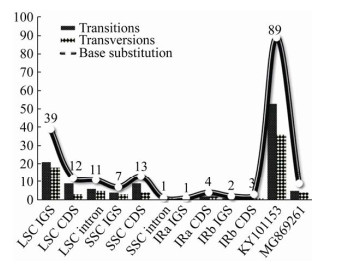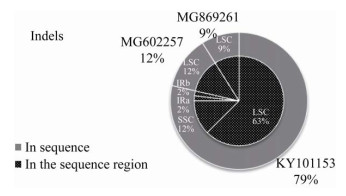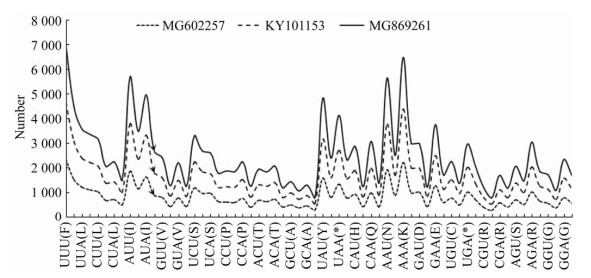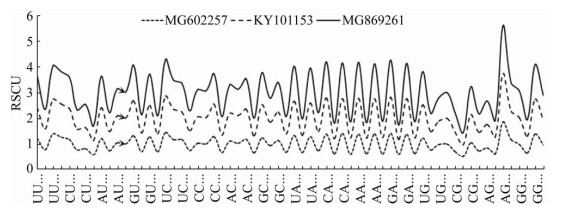
 , 张凯2, 段义忠2
, 张凯2, 段义忠2

1. 河南科技大学 农学院,河南 洛阳 471003;
2. 榆林学院 生命科学学院,陕西 榆林 719000
收稿日期:2020-04-06;接收日期:2020-07-28
基金项目:国家自然科学基金(Nos. 21675125,41601059),河南科技大学学科提升振兴A计划项目(No. 13660001)资助
摘要:蔷薇科桃属植物长柄扁桃Amygdalus pedunculata Pall.是我国重点发展的12种木本油料作物之一。将自然生长在陕西省榆林市毛乌素沙地的长柄扁桃进行高通量测序、组装得到了GenBank登录号为MG602257的长柄扁桃叶绿体基因组。与NCBI中其他两个长柄扁桃叶绿体基因组(MG869261和KY101153)进行序列比对发现:长柄扁桃叶绿体基因组均呈现典型的4分区域结构;基因组序列GC含量均是36.8%;总长度MG602257 < MG869261 < KY101153,分别为157 851 bp、157 873 bp和157 948 bp;3个叶绿体基因组存在149个突变位点,包括93次替换事件、56次插入缺失事件、无小倒位事件。长柄扁桃叶绿体基因组密码子数目和RSCU值偏性分析具有极高的相似性。3个长柄扁桃叶绿体基因组在JLB/JSB/JSA/JLA四个边界有相同的基因类型和排列顺序,但在LSC/IRa边界JSA中,ndhF基因在MG602257和MG869261中的总长度相同,而在KY101153中总长度增加9 bp;ycf1基因横跨IRb/SSC边界区,基因长度在MG602257、MG869261和KY101153中分别为5 657、5 588、5 684 bp,是造成全叶绿体基因长度差异的因素之一。基于全叶绿体基因组序列构建的系统发育进化树显示,3个长柄扁桃序列和一个榆叶梅序列聚在同一分支,说明榆叶梅和长柄扁桃亲缘关系较近。研究结果为长柄扁桃的叶绿体转基因工程、种质资源开发应用提供了基础实验数据。
关键词:长柄扁桃蔷薇科叶绿体基因组密码子高通量测序
Comparison of complete chloroplast genome sequences of Amygdalus pedunculata Pall.
Chunyan Duan1

 , Kay Zhang2, Yizhong Duan2
, Kay Zhang2, Yizhong Duan2

1. Agricultural College, Henan University of Science and Technology, Luoyang 471003, Henan, China;
2. College of Life Sciences, Yulin University, Yulin 719000, Shaanxi, China
Received: April 6, 2020; Accepted: July 28, 2020
Supported by: National Natural Science Foundation of China (Nos. 21675125, 41601059), Fund of the Henan University of Science and Technology (No. 13660001)
Corresponding author: Chunyan Duan. Tel/Fax: +86-379-64282340; E-mail: dchy@haust.edu.cn;
Yizhong Duan. E-mail: 1445262292@qq.com.
Abstract: Amygdalus pedunculata Pall. is one of the 12 important woody oil crops in China. In this study, we determined the complete chloroplast genome sequence of A. pedunculata Pall. (MG602257) from Mu Us desert in Yulin city, Shaanxi province, China. The plastome was 157 851 bp with 36.8% GC content. Comparisons among the plastomes of MG602257 and other two MG869261 and KY101153 from Genebank of NCBI showed that the total length of these chloroplast genomes was MG602257 < MG869261 < KY101153, the GC contents of these genomes were same, and 149 mutation events including 93 substitutions and 56 indels were accurately located. The codon numbers and RSCU values among the three were similar. They shared the same genes at the four boundaries of the LSC, SSC, IRa, and IRb regions. The lengths of ndhF at the LSC/IRa boundary in MG602257 and MG869261 were same while adjusting 9 bp in KY101153. The length of ycf1 gene at the SSC/IRb boundary in MG602257, MG869261 and KY101153 was 5 657, 5 588 and 5 684 bp, respectively, which was the one of the reasons for the size difference among the three plastomes. Phylogenetic analyses based on 13 complete plastomes of Rosaceae species confirmed close relationships between A. trilob and A. pedunculata.
Keywords: Amygdalus pedunculataRosaceaechloroplast genomecodonhigh throughput sequencing
长柄扁桃Amygdalus pedunculata,中文名野樱桃、毛樱桃,多年生灌木,耐寒抗旱,为蔷薇科李亚科桃属扁桃亚属植物,主要分布于中国西北部与毛乌素沙地,是生产生物柴油、活性炭、高品质食用油、蛋白粉、甘油、苦杏仁苷等产品的重要原料和我国重点发展的12种木本油料作物之一;长柄扁桃油是我国新资源食品原料[1-4]。长柄扁桃属于重点保护植物、濒危植物[5-8]和药食同源植物[9-10]。研究发现长柄扁桃种仁含有苦杏仁苷[11]和多种不饱和脂肪酸[12]。苦杏仁苷具有抑制肿瘤和炎症、组织器官纤维化等多种药理功能[13]。不饱和脂肪酸可缓解动脉粥样硬化并有降低血脂作用[14-15]。长柄扁桃生态效用显著,具有防风固沙稳定荒漠地区脆弱生态系统的作用[2-3, 6, 16]。研究长柄扁桃叶绿体基因组成和系统地位对保护和开发应用濒危植物有重要的学术价值。植物是生产者,叶绿体为光合作用场所,主要存在于植物绿色部位[17]。叶绿体基因组中有光合作用、能量代谢、同化或未知等多种类型基因[18-20]。叶绿体基因组是研究高等植物物种形成、种质资源遗传多样性和基因工程技术等方面理论基础和实验材料。长柄扁桃属于蔷薇科桃属Amygdalus,近缘植物的叶绿体基因组多有被报道[21-28]。人参Panax ginseng[29]、丹参Salvia miltiorrhiza[30]叶绿体基因组已被成功组装。叶绿体基因组序列在揭示物种形成起源、物种之间亲缘关系方面始终具有重要价值[31-33]。长柄扁桃是濒危保护植物、优良木本油料植物、药食同源植物和园林观赏植物,具有十分重要的经济价值和应用价值。本研究以原料植物长柄扁桃为材料,通过二代测序,取得其叶绿体基因NCBI登录号MG602257[28]。从叶绿体基因序列结构特征、密码子组成分析和IR/SC边界等方面对长柄扁桃的叶绿体基因组进行对比分析,基于全叶绿体基因组数据构建进化树,以期为濒危物种长柄扁桃叶绿体基因工程、分子遗传变异、种质资源开发提供一定理论基础和实验依据。
1 材料与方法1.1 长柄扁桃叶绿体基因高通量测序试验材料为毛乌素沙地自然分布区的长柄扁桃野生生长植株。采集长柄扁桃新鲜幼嫩叶片,于Illumina平台建库高通量测序,在NCBI网站(http://www.ncbi.nlm.nih.gov/)注册得到A. pedunculata叶绿体基因序列登录号。
1.2 长柄扁桃叶绿体基因组学分析运用MEGA5.5[34]、BioEdit[35]、Geneious[36]、Mafft7.037[37]、IRscope (https://irscope.shinyapps.io/irapp/)和CodonW1.4.2软件[38-40]对NCBI中长柄扁桃叶绿体基因组序列特征进行分析。
1.3 长柄扁桃叶绿体基因组系统发育分析采用MEGA5.5与Geneious软件,以Kimura-2为参数基于1 000次Bootstrap value构建邻接法(Neighbor-joining,NJ)系统进化树。
2 结果与分析2.1 长柄扁桃高能量测序基因序列注册情况本次高通量测序获得注册号MG602257,与NCBI中登录号NC_037850为同一序列。
2.2 长柄扁桃叶绿体基因组学分析2.2.1 叶绿体基因组基本特征与边界情况将MG602257、KY101153、MG869261[27]长柄扁桃叶绿体基因组结构与序列情况进行分析比对(图 1–2与表 1)。从图 1中可观察到,长柄扁桃的叶绿体基因组呈现典型的4分区域结构,即大单拷LSC、SSC以及两个大小相同反向重复区IR。3条长柄扁桃叶绿体基因基本特征信息见表 1。长柄扁桃叶绿体基因组总长度MG602257 < MG869261 < KY101153,分别为157 851 bp、157 873 bp和157 948 bp。叶绿体基因4分区域结构中SSC与IR长度较LSC长度小,LSC长度往往最大。长柄扁桃叶绿体基因组LSC长度MG602257 < MG869261 < KY101153,分别为86 052 bp、86 074 bp和86 144 bp。SSC长度变化差异不大,MG602257=MG869261 < KY101153,分别为19 029 bp、19 029 bp和19 056 bp。IRa与IRb长度相同,长柄扁桃叶绿体基因组IRa长度MG602257与MG869261相同,但均大于总长度第一的KY101153,分别为26 385 bp、26 385 bp和26 374 bp。长柄扁桃叶绿体基因总长度序列差22–97 bp,在LSC区长度变化最大,IR区长度变化最小,3个叶绿体基因组中SSC区与IR区长度相对稳定;长柄扁桃的序列A/T/C/G含量以及AT含量数值相同;编码的基因数目129–131个,外显子数目和tRNA、rRNA基因数目在MG602257、MG869261和KY101153无差异。从长柄扁桃现有3条叶绿体基因组长度变化分析来看,其总长度变化规律与分区变化规律无相关性。LSC区变化相对更多,但SSC区与IR区长度保守,在MG602257与MG869261两个叶绿体基因组中两个区域长度均相同。
 |
| 图 1 长柄扁桃的叶绿体基因组4分区域结构 Fig. 1 Four segments in the chloroplast genomes of A. pedunculata. |
| 图选项 |
 |
| 图 2 长柄扁桃的叶绿体基因组LSC和SSC、IR边界比对 Fig. 2 Comparison of the junction between IR, LSC, SSC of the chloroplast genomes from A. pedunculata. |
| 图选项 |
表 1 长柄扁桃叶绿体基因组特征比较Table 1 Comparison of chloroplast genome features in A. pedunculata
| Genome feature | Name of the species A. pedunculata | Difference | ||
| Accession number | KY101153 | MG602257 | MG869261 | – |
| Genome (bp) | 157 948 | 157 851 | 157 873 | 22–97 |
| LSC length (bp) | 86 144 | 86 052 | 86 074 | 22–92 |
| SSC length (bp) | 19 056 | 19 029 | 19 029 | 0–27 |
| IR length (bp) | 26 374 | 26 385 | 26 385 | 0–11 |
| A content (%) | 31.1 | 31.1 | 31.1 | 0 |
| G content (%) | 18.0 | 18.0 | 18.0 | 0 |
| T content (%) | 32.1 | 32.1 | 32.1 | 0 |
| C content (%) | 18.8 | 18.8 | 18.8 | 0 |
| Overal GC content (%) | 36.8 | 36.8 | 36.8 | 0 |
| AT content (%) | 63.2 | 63.2 | 63.24 | 0 |
| Number of CDS (Number of protein-coding genes) | 85 | 84 | 86 | 1–2 |
| Number of exons | 32 | 32 | 32 | 0 |
| Number of genes | 130 | 129 | 131 | 1–2 |
| Number of rRNAs genes | 8 | 8 | 8 | 0 |
| Number of tRNAs genes | 37 | 37 | 37 | 0 |
表选项
长柄扁桃3个叶绿体基因组的IR/SSC区的边界如图 2所示。长柄扁桃在IR区边界处情况具有相同点,即MG602257、MG869261和KY101153在JLB/JSB/JSA/JLA四个边界有相同的基因类型和排列顺序,分别为LSC/IRb的rpl22、rps19和rpl2,LSC/IRa的rpl2、rps19和trnH,IRb/SSC的ycf1,SSC/IRa的ndhF。长柄扁桃rps19基因横跨IRb/LSC边界区,rps19基因在MG602257、MG869261和KY101153总长279 bp,长度相同;MG602257和MG869261的rps19基因均在JLB区进入IRb区的长度为187 bp;而在KY101153中,rps19基因进入IRb区的长度为182 bp;即rps19基因在MG602257与KY101153中,表现不同;rps19基因在IR区占据比例较LSC区多,rps19基因长度总差值在3个叶绿体基因组为0,但在IRa区中扩张差值有5 bp。长柄扁桃ycf1基因在MG602257、MG869261和KY101153横跨IRb/SSC边界区,ycf1基因长度不同,总长分别为5 657、5 588、5 684 bp;ycf1基因长度大小与总叶绿体基因组总长变化趋向相同,可能具有正相关性。在LSC/IRa边界JSA中,ndhF基因在MG602257、MG869261中总长度相同均为2 237 bp,表现相同,均扩张到IRa区18 bp;ndhF基因在KY101153总长度小一些,为2 228 bp,扩张到IRa区2 bp。总体上,MG602257与MG869261在边界基因相似性大于KY101153。
2.2.2 叶绿体基因组突变情况核苷酸替换情况和插入缺失在物种进化历程中有十分重要的影响,是分子变化和演化的基础。对长柄扁桃叶绿体基因组的3个序列突变情况进行分析(图 3–5),共检测到149个突变位点,其中93次为替换事件,56次为插入缺失事件,未发现序列中有小倒位事件。如图 3所示,替换事件发生的主要区域在LSC区的基因间隔区,占总体数目42%,为39次;其次是SSC区的蛋白编码区,为13次。在SC区中总共发生了82次,占88.2%,IR区中发生替换11次,占11.8%。说明SC区较IR区易发生序列变化,IR区较SC区保守。KY101153序列中有89次替换事件,发生次数远大于MG869261,因此,在长柄扁桃3个序列中,MG869261可能与MG602257较KY101153有更高同源性。图中显示转换较颠换发生次数多。KY101153序列中转换发生53次,比颠换多了17次。在SSC区中CDS发现13次替换事件,其中转换发生9次,为颠换发现次数的2.25倍,说明长柄扁桃叶绿体序列中,转换较颠换发生机率较大。
 |
| 图 3 长柄扁桃的叶绿体基因组替换情况 Fig. 3 The total numbers of substitutions in the chloroplast genomes of A. pedunculata. IGS: intergenic spacer; Intron: intron region; CDS: protein coding region. |
| 图选项 |
 |
| 图 4 长柄扁桃的叶绿体基因组不同序列插入缺失事件分布情况 Fig. 4 The distribution of indels in the chloroplast genomes of A. pedunculata. |
| 图选项 |
 |
| 图 5 长柄扁桃的叶绿体基因组插入缺失类型与数目 Fig. 5 Types and numbers of indels in the chloroplast genomes of A. pedunculata. |
| 图选项 |
长柄扁桃3个序列中插入缺失情况不同。如图 4所示,KY101153、MG869261与MG602257发生次数分别为44、5、7,对应百分比分别为79%、9%、12%。KY101153中Indels发生在序列的LSC区、SSC区和IR区;MG869261与MG602257全部分布在LSC区。Indels主要发生在序列的LSC区,发生次数为47,达到84%。图 5显示了长柄扁桃的叶绿体基因组插入缺失类型与数目。共有11种类型,即1、2、3、4、5、6、7、14、15、20、23、27 bp。由图 4可以看到,1 bp为主要类型,其中插入发生数目为12个,缺失发生数目为19个。14 bp至23 bp类型则发生数目均只有1次。
2.2.3 叶绿体基因组密码子组成通过Mega5.5、CodonW软件对长柄扁桃叶绿体基因组的密码子组成进行分析。RSCU > 1,说明该密码子的使用频率较高;RSCU=1,该密码子无使用偏好性[40]。结果表明(图 6–7),MG602257序列中有52 617个密码子,UUU编码苯丙氨酸,有2 344个,是数目最多的密码子;CGC编码精氨酸,有262个,是数目最少的密码子;编码亮氨酸的密码子数目最多,达到5 135个,占全部密码子总量的9.76%;编码色氨酸的密码子有691个,数目最少,仅占总量1.31%。MG602257密码子RSCU > 1的类型有31个,其中以A/T碱基结尾的有26个,占总数目的83.87%,表明编码长柄扁桃的密码子偏向以A/T结尾。KY101153共有52 649个密码子,在所有密码子中,UUU最多,有2 293个;而CGC最少,只有255个;UAA是最常用的终止密码子,其数量为1 381个,高于UAG (789个)和UGA (1 005个)。MG869261共有52 624个密码子,在所有密码子中,同样是UUU数目最多,有2 319个;而CGC类型的密码子最少,只有255个;UAA数目为1 415,高于UGA和UAG的数量。长柄扁桃3个叶绿体序列的密码子使用情况在图 6与图 7折线图中有相似的变化弯曲,显示出高度保守性。
 |
| 图 6 长柄扁桃叶绿体基因组密码子的数目对比 Fig. 6 The codon usage numbers of the chloroplast genomes of A. pedunculata. |
| 图选项 |
 |
| 图 7 长柄扁桃叶绿体基因组密码子的RSCU值对比 Fig. 7 The relative synonymous codon usage of the chloroplast genomes of A. pedunculata. RSCU: relative synonymous codon usage. |
| 图选项 |
2.3 系统发育长柄扁桃和同属物种榆叶梅是多倍体植物,分类地位一直有争议[41-44]。在分子系统学中,高等植物叶绿体基因是研究植物分类中可依赖的材料。为阐明长柄扁桃在扁桃亚属上的系统进化位置和与近缘种的亲缘关系,本研究选取NCBI中全部已有的长柄扁桃叶绿体基因组,加上已公布的共9个物种的13条叶绿体基因组序列为研究对象构建进化树。选取的植物物种叶绿体基因组具体情况如表 2所示。以MEGA5.5和Geneious软件构建NJ进化树如图 8所示。图 8中结果显示长柄扁桃MG602257、MG869261和KY101153三条序列聚为一支,KY101153与榆叶梅聚为一小支,显示长柄扁桃和榆叶梅亲缘关系相近,研究结果与董山平等****结论一致[4, 41-44]。
表 2 长柄扁桃系统发育分析所选物种和序列NCBI登陆号Table 2 Chloroplast genomes in present study
| Family | Genus | Species | Accession number |
| Rosaceae | Amygdalus | Amygdalus pedunculata | MG602257 |
| Amygdalus pedunculata | MG869261 | ||
| Amygdalus pedunculata | KY101153 | ||
| Amygdalus mongolica | KY073235 | ||
| Amygdalus triloba | KY101155 | ||
| Amygdalus dulcis cul. Zhipi | MH727486 | ||
| Amygdalus tenella | NC_044965 | ||
| Amygdalus mira | MK798147 | ||
| Amygdalus mira | KX889393 | ||
| Amygdalus kansuensis | KF990036 | ||
| Amygdalus davidiana | MK798145 | ||
| Amygdalus davidiana | MH460864 | ||
| Cerasus | Cerasus yedoensis | KU985054 |
表选项
 |
| 图 8 基于叶绿体全基因组的长柄扁桃NJ系统发育树 Fig. 8 The NJ phylogenetic tree was constructed based on the chloroplast genomes in NCBI. Numbers above branches are bootstrap support and only values larger than 80% were shown. |
| 图选项 |
3 讨论长柄扁桃是濒危的重点规划发展的木本油料植物,是生产生物柴油和高档食用油及医药原料来源物种,具有十分重要的开发价值。本研究通过二代高通量测序技术得到了NCBI登录号为MG602257的长柄扁桃叶绿体全基因序列。运用生物信息学方法,对NCBI中长柄扁桃所有的叶绿体基因组进行结构、序列特征和IR/SC区的边界情况对比分析。基于长柄扁桃全部叶绿体基因序列,构建NJ系统进化树。研究发现长柄扁桃MG602257叶绿体基因组全长157 851 bp,分为经典4个区域(1个LSC、2个IR和1个SSC),3个长柄扁桃叶绿体序列长度相差最少在22 bp,最多达97 bp。IR与SSC序列长度变化较少。长柄扁桃所有叶绿体基因组注释基因类型中,外显子数目相同,均为32个。3个长柄扁桃叶绿体序列中SC区较IR区易发生序列变化,IR区较SC区保守。替换事件发生为93次,主要区域在LSC区的基因间隔区,占总体数目42%;其次是SSC区的蛋白编码区,为13次。在SC区中总共发生了82次,占88.2%。高等植物叶绿体基因组可独立构建可信的植物系统发育进化树。本研究构建的系统发育树显示长柄扁桃与榆叶梅物种亲缘关系较近。由于当前关于长柄扁桃以及其近缘种的叶绿体全基因组数据十分有限,因此,需要获得更多相关叶绿体基因组序列才能后续更细致深入研究。长柄扁桃是濒危物种,同时是优良的生产原料物种,应加强对其生物多样性和遗传多样性的保护。本次研究为长柄扁桃物种保护、系统演化、叶绿体基因工程和种质资源开发应用方面提供相关实验数据和理论依据。
参考文献
| [1] | Lu CR, Li HY, Li C, et al. Chemical composition and radical scavenging activity of Amygdalus pedunculata Pall. leaves' essential oil. Food Chem Toxicol, 2018, 119: 368-374. DOI:10.1016/j.fct.2018.02.012 |
| [2] | Li C, Yang JZ, Yao L, et al. Characterisation, physicochemical and functional properties of protein isolates from Amygdalus pedunculata Pall. seeds. Food Chem, 2020, 311: 125888. DOI:10.1016/j.foodchem.2019.125888 |
| [3] | Chu JM, Xu XQ, Zhang YL. Production and properties of biodiesel produced from Amygdalus pedunculata Pall. Bioresour Technol, 2013, 134: 374-376. DOI:10.1016/j.biortech.2012.12.089 |
| [4] | Qiu R, Cheng ZP, Wang ZL. Studies on genetic relationship and evolutionary path of Subgenus Amygdalus in China. Acta Horticult Sin, 2012, 39(2): 205-214 (in Chinese). 邱蓉, 程中平, 王章利. 中国扁桃亚属植物亲缘关系及其演化途径研究. 园艺学报, 2012, 39(2): 205-214. |
| [5] | Fu LG, Jin JM. China plant red data book, vol. 1: rare and endangered plants. Beijing: Science Press, 1991 (in Chinese). 傅立国, 金鉴明. 中国植物红皮书:稀有濒危植物(第一册). 北京: 科学出版社, 1991. |
| [6] | Huang LM, Shao MA, Pei YL, et al. Review on biological characteristics and abiotic stress tolerance mechanisms and applications of Amygdalus pedunculata. Soils, 2019, 51(2): 217-223 (in Chinese). 黄来明, 邵明安, 裴艳武, 等. 沙地濒危植物长柄扁桃生物学特性与抗逆性及应用综述. 土壤, 2019, 51(2): 217-223. |
| [7] | Zhao YZ. Rare and endangered plants in Inner Mongolia. Beijing: China Agricultural Science and Technology Press, 1992 (in Chinese). 赵一之. 内蒙古珍稀濒危植物图谱. 北京: 中国农业科技出版社, 1992. |
| [8] | Li DW, Dang KL, Wen ZM, et al. Research of rare and endangered plants of seed plant flora in loess plateau. Acta Bot Boreal Occident Sin, 2004, 24(12): 2321-2328 (in Chinese). 李登武, 党坤良, 温仲明, 等. 黄土高原地区种子植物区系中的珍稀濒危植物研究. 西北植物学报, 2004, 24(12): 2321-2328. DOI:10.3321/j.issn:1000-4025.2004.12.023 |
| [9] | Liu XJ, Zhang YQ, Li J. Research of bencaological study and chemical constiutents of Pruni semen. J Liaoning Univ Tradit Chin Med, 2017, 19(12): 100-103 (in Chinese). 刘星劼, 张永清, 李佳. 中药郁李仁本草考证及化学成分研究. 辽宁中医药大学学报, 2017, 19(12): 100-103. |
| [10] | Liu WL, Zheng Q, Zhang KN, et al. Advances in safety evaluation of medicinal and edible Chinese materia medica of wood, fruit and herb categories. Chin Tradit Herbal Drugs, 2019, 50(10): 2505-2512 (in Chinese). 刘吴玲, 郑琴, 张科楠, 等. 木部类、果部类和草部类药食同源中药安全性评价研究进展. 中草药, 2019, 50(10): 2505-2512. DOI:10.7501/j.issn.0253-2670.2019.10.035 |
| [11] | Zhang P, Shen YH, Wang XL, et al. Determination of amygdalin in Amygdalus pedunculatus Pall. by high performance liquid chromatography. Chin J Anal Lab, 2007, 26(10): 80-83 (in Chinese). 张萍, 申烨华, 王晓玲, 等. 高效液相色谱法测定长柄扁桃仁中的苦杏仁甙. 分析实验室, 2007, 26(10): 80-83. |
| [12] | Li C, Li GP, Chen Q, et al. Fatty acid composition analysis of the seed oil of Amygdalus pedunculatus Pall. China Oils Fats, 2010, 35(4): 77-79 (in Chinese). 李聪, 李国平, 陈俏, 等. 长柄扁桃油脂肪酸成分分析. 中国油脂, 2010, 35(4): 77-79. |
| [13] | Deng JG, Li CY, Wang HL, et al. Amygdalin mediates relieved atherosclerosis in apolipoprotein E deficient mice through the induction of regulatory T cells. Biochem Biophys Res Commun, 2011, 411(3): 523-529. |
| [14] | Zhang JX, Zhang LJ, Wang LB, et al. Effect of Tenebrio molitor oil on blood lipid and antioxidant function in hyperlipidemic mice. Food Sci, 2011, 32(5): 263-266 (in Chinese). 张建新, 张立佳, 王临宾, 等. 黄粉虫油对高脂血症小鼠血脂水平及抗氧化能力的影响. 食品科学, 2011, 32(5): 263-266. |
| [15] | Zhao YW, Qiu NX, Gao X, et al. Preventive and therapeutical effect of Apple seed oil on experimental hyperlipidemia in rats. J Fourth Milit Med Univ, 2008, 29(6): 556-558 (in Chinese). 赵雁武, 仇农学, 高霞, 等. 苹果籽油对实验性高脂血症大鼠的防治作用. 第四军医大学学报, 2008, 29(6): 556-558. DOI:10.3321/j.issn:1000-2790.2008.06.024 |
| [16] | Wang W, Wang HL, Xiao XZ, et al. Wild almond (Amygdalus pedunculata Pall.) as potential nutritional resource for the future: studies on its chemical composition and nutritional value. J Food Meas Charact, 2018, 13: 250-258. |
| [17] | Daniell H, Lin CS, Yu M, et al. Chloroplast genomes: Diversity, evolution, and applications in genetic engineering. Genome Biol, 2016, 17: 134. DOI:10.1186/s13059-016-1004-2 |
| [18] | Bobik K, Burch-Smith TM. Chloroplast signaling within, between and beyond cells. Front Plant Sci, 2015, 6: 781. |
| [19] | Smith DR. Evolution: In chloroplast genomes, anything goes. Current Biol, 2017, 27(24): R1305-R1307. DOI:10.1016/j.cub.2017.10.049 |
| [20] | Zoschke R, Bock R. Chloroplast translation: Structural and functional organization, operational control, and regulation. Plant Cell, 2018, 30(4): 745-770. |
| [21] | Duan CY, Shen YH, Zhao GF. Complete chloroplast genome characteristics of Prunus triloba Lindl. Mitochond DNA Part B Resour, 2020, 5(1): 504-505. DOI:10.1080/23802359.2019.1704657 |
| [22] | Feng Y, Liu T, Wang XY, et al. Characterization of the complete chloroplast genome of the Chinese cherry Prunus pseudocerasus (Rosaceae). Conservat Genet Resour, 2018, 10(1): 85-88. DOI:10.1007/s12686-017-0770-9 |
| [23] | Cho MS, Cho CH, Kim SY, et al. Complete chloroplast genome of Prunus yedoensis Matsum. (Rosaceae), wild and endemic flowering cherry on Jeju Island, Korea. Mitochondr DNA Part A, 2016, 27(5): 3650-3654. DOI:10.3109/19401736.2015.1079839 |
| [24] | Chen T, Wang Y, Wang L, et al. The complete chloroplast genome of Tomentosa cherry Prunus tomentosa (Prunoideae, Rosaceae). Mitochond DNA Part B Resour, 2018, 3(2): 672-673. DOI:10.1080/23802359.2018.1476068 |
| [25] | Cho MS, Yang JY, Kim SC. Complete chloroplast genome of Ulleung Island endemic flowering cherry, Prunus takesimensis (Rosaceae), in Korea. Mitochondr DNA Part B Resour, 2018, 3(1): 274-275. DOI:10.1080/23802359.2018.1443034 |
| [26] | Liu J, Ni SB, Zheng C, et al. Complete Genome of tropical and sub-tropical fruit tree Syzygium samarangense (Myrtaceae). Mitochond DNA Part B Resour, 2018, 3(2): 890-891. DOI:10.1080/23802359.2018.1501296 |
| [27] | Wang W, Wang HL, Xiao XZ, et al. Characterization of the complete chloroplast genome of longstalk almond (Prunus pedunculata (Pall.) Maxim.), an important sand-fixation shrub plant endemic to northern China. Conservation Genet Resour, 2019, 11(4): 419-421. DOI:10.1007/s12686-018-1039-7 |
| [28] | Duan YZ, Shen YH, Kang FR, et al. Characterization of the complete chloroplast genomes of the endangered shrub species Prunus mongolica and Prunus pedunculata (Rosales: rosaceae). Conservation Genet Resour, 2019, 11(3): 249-252. DOI:10.1007/s12686-017-0979-7 |
| [29] | Zhao YB, Yin JL, Guo HY, et al. The complete chloroplast genome provides insight into the evolution and polymorphism of Panax ginseng. Front Plant Sci, 2014, 5: 696. |
| [30] | Curci PL, de Paola D, Danzi D, et al. Complete chloroplast genome of the multifunctional crop globe artichoke and comparison with other Asteraceae. PLoS ONE, 2015, 10(3): e0120589. DOI:10.1371/journal.pone.0120589 |
| [31] | Xing SC, Liu CJ. Progress in chloroplast genome analysis. Progr Biochem Biophys, 2008, 35(1): 21-28 (in Chinese). 邢少辰, Liu CJ. 叶绿体基因组研究进展. 生物化学与生物物理进展, 2008, 35(1): 21-28. DOI:10.3321/j.issn:1000-3282.2008.01.004 |
| [32] | Zuo RH, Jiang P, Sun CB, et al. Analysis of the chloroplast genome characteristics of Rhus chinensis by de novo sequencing. Chin J Biotech, 2020, 36(4): 772-781 (in Chinese). 左瑞华, 蒋平, 孙传伯, 等. 基于全基因组从头测序技术盐肤木叶绿体基因组的测序分析. 生物工程学报, 2020, 36(4): 772-781. |
| [33] | Su T, Zhan YG, Han M, et al. Chloroplast genetic engineering: A new approach in plant biotechnology. Chin J Biotech, 2005, 21(4): 674-680 (in Chinese). 苏涛, 詹亚光, 韩梅, 等. 叶绿体基因工程:一种植物生物技术的新方法. 生物工程学报, 2005, 21(4): 674-680. DOI:10.3321/j.issn:1000-3061.2005.04.032 |
| [34] | Kumar S, Stecher G, Tamura K. MEGA7: molecular evolutionary genetics analysis version 7.0 for bigger datasets. Mol Biol Evol, 2016, 33(7): 1870-1874. DOI:10.1093/molbev/msw054 |
| [35] | Tippmann HF. Analysis for free: comparing programs for sequence analysis. Briefings Bioinf, 2004, 5(1): 82-87. DOI:10.1093/bib/5.1.82 |
| [36] | Kearse M, Moir R, Wilson A, et al. Geneious Basic: an integrated and extendable desktop software platform for the organization and analysis of sequence data. Bioinformatics, 2012, 28(12): 1647-1649. DOI:10.1093/bioinformatics/bts199 |
| [37] | Katoh K, Misawa K, Kuma Ke, et al. MAFFT: a novel method for rapid multiple sequence alignment based on fast Fourier transform. Nucleic Acids Res, 2002, 30(14): 3059-3066. DOI:10.1093/nar/gkf436 |
| [38] | Peden JF. Analysis of codon usage[D]. Nottingham: University of Nottingham, 1999. |
| [39] | Sharp PM, Li WH. The codon Adaptation Index—a measure of directional synonymous codon usage bias, and its potential applications. Nucleic Acids Res, 1987, 15(3): 1281-1295. DOI:10.1093/nar/15.3.1281 |
| [40] | Sharp PM, Tuohy TMF, Mosurski KR. Codon usage in yeast: cluster analysis clearly differentiates highly and lowly expressed genes. Nucleic Acids Res, 1986, 14(13): 5125-5143. DOI:10.1093/nar/14.13.5125 |
| [41] | Dong SP. Phylogeny research of Prunus triloba and related species based on Chromosome kayotype and Single-copy nuclear gene DNA sequences[D]. Beijing: Beijing Forestry University, 2015 (in Chinese). 董山平.基于染色体核型和单拷贝核基因DNA序列的榆叶梅及其近缘种系统学研究[D].北京: 北京林业大学, 2015. |
| [42] | Dong SP, Luo L, Zhong JQ, et al. Analysis of karyotypes of Prunus triloba and four related Species. Acta Bot Boreal Occident Sin, 2015, 35(3): 608-613 (in Chinese). 董山平, 罗乐, 钟军珺, 等. 榆叶梅及其部分近缘种的染色体核型分析. 西北植物学报, 2015, 35(3): 608-613. |
| [43] | Yazbek M, Oh SH. Peaches and almonds: Phylogeny of Prunus subg. Amygdalus (Rosaceae) based on DNA sequences and morphology. Plant Syst Evol, 2013, 299(8): 1403-1418. DOI:10.1007/s00606-013-0802-1 |
| [44] | Zhang QJ. Studies on P. tomentosa genetic diversity and relationships with relative species in Prunus[D]. Shenyang: Shenyang Agricultural University, 2007 (in Chinese). 张琪静.毛樱桃资源遗传多样性及与李属近缘种亲缘关系的研究[D].沈阳: 沈阳农业大学, 2007. |
